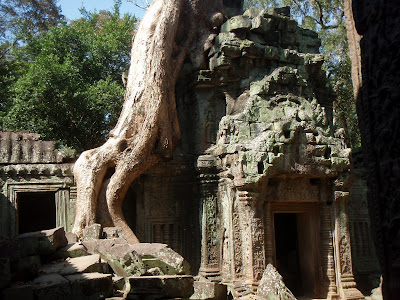It's taken me a while but I'm finally getting a post up on the Angkor Temple complexes. Part of the difficulty in this was trying to select photos that captured what made the place so impressive. In the end I think that is an impossible task, as what makes for a very thrilling first hand experience often does not translate into a good picture. In real life we experience depth and atmosphere in a very different way, and we are far less concerned with color contrast or lighting. In many ways I feel that photography is a vex on travel. While it's great to be able to show people what you saw, the pictures in many ways lie about the destination, making it more or less than it actually is. Some sites. like the Taj Mahal, photograph beautifully and yet are dull in first hand experience, where as sites like the Grand Palace in Bangkok are quite interesting they fail to photograph in a way that captures everything interesting about the site.
Aproach to Angkor Wat
And so it is with a curious mix that Angkor is one of the few sites that I have visited that both photographs really well but is also an astonishing place to visit, even if for completely different reasons. The photographs fail to capture the symmetry of the structures in their interiors, and how hallways cascade from one to the next their doorways framing other structures or temples beyond. Pictures fail to capture the vertical component of the buildings with the same sense that is bestowed upon the visitor. Scaling the steps of these towers was exhilarating and not for the faint of heart, as they are quite steep, much like the step pyramids in Mexico. The pictures then fail to really get that same vertical component as you gaze out over the jungle from the various different levels of the structure and look back down upon the structure itself.
Strangler Fig Growing On Top of the Ruins
While the strangler figs growing on top of the ruins photograph quite nicely and are cool in real life, the sense of ruins deep in the jungle is really brought more to life as you stumble over stones and vines in the paths that connect the various temple sites. what most people don't realize is that the temples of Angkor are much more than just Angkor Wat, and are spread over a very large area, one large enough that you need to either hire a tuk-tuk or rent a bike in order to get around and see them with any velocity. Vine covered leaning walls in the thick of the jungle and gates topped with crumbling giant faces staring out into the jungle evoke a sense of awe that is replicated at very few ruins I've visited on this planet. (My short list might include; Machu Picchu in Peru, Petra in Jordan, Pamukale in Turkey, and the Temple of Karnak in Egypt)
Water temple, that had four pools around one central pool with naga statues
So while I'm thrilled to be able to share with other people what I have seen in my travels through photos, it is a shame that you can not in any real way share the experience of actually being at these kind of sites. It is impossible to capture in any real way. So while I hope you enjoy some of these pictures of the amazing sites of the Angkor temples, I hope it only wets your appetite, and maybe the next time you find yourself in the neighborhood of south east Asia you stop by Siem Reap and see it for yourself, because it's the only way to really see all that is there.
Temple complex constructed of brick flanked by lions
Sunrise over Angkor Wat, seen from a lily pond.
Moon in the sky over the west entry to Angkor Wat
Buddha Statue at Bayon Temple
Statuary Heads top the towers of Bayon Temple
Jungle and strangler figs reclaim the temples









No comments:
Post a Comment